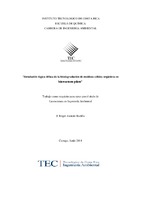Mostrar el registro sencillo del ítem
Simulación lógica difusa de la biodegradación de residuos sólidos orgánicos en bioreactores piloto
| dc.contributor.author | Atencio-Badilla, Róger | |
| dc.date.accessioned | 2014-08-11T14:33:49Z | |
| dc.date.available | 2014-08-11T14:33:49Z | |
| dc.date.issued | 2014 | |
| dc.identifier.uri | https://hdl.handle.net/2238/3276 | |
| dc.description | Proyecto de Graduación (Licenciatura en Ingeniería Ambiental) Instituto Tecnológico de Costa Rica, Escuela de Química, 2014. | |
| dc.description.abstract | The Bioreactor Landfill (BL) is an emerging concept that has gained attention in recent years. This technology uses specific operational practices (leachate recirculation control, nutrients, pH adjustments, etc.) to optimize biodegradation processes in the system. However if the design and operation is not controlled (specifically manipulation leachate and recycling process) typically results in loss of system efficiency. This is why it is necessary to generate models to approximate the system behavior under different operational conditions and achieve set the optimal parameters for the biodegradation of solid waste. The aim of this work was to develop a model of the biodegradation of organic solid waste that allows to know the ideal rate of leachate recirculation as volume per unit time per kilogram of waste. For this soft computing method Fuzzy Logic (FL) was used to fit the uncertainty, complexity and non-linearity of the processes occurring in BL. For this purpose 22 bioreactors (30 cm height and 12,5 cm diameter) were constructed with 1 kg of homogenized organic solid waste each one. An experimental design was set up with three recirculation treatments: 250 mL/day (RB), 500 mL/day (RM), 750 mL/day (RA) and response factor as the value of the chemical oxygen demand (COD) was considered over a period of 182 days. At the end of the period of 182 days of observation treatments with recirculation rates of 500 and 750 mL (RM and RA) of leachate per day per kilogram of residue, showed a higher removal efficiency of COD (17 150 mg/L and 14 621 mg/L respectively) while treatment with 250 mL (RB) of leachate per day per kilogram provided the highest reading of COD (22 351 mg / L) at the end of the observation period . With these results it was possible to develop a preliminary model for predicting COD biodegradation of organic solid waste, based on the approach of Fuzzy Logic. This model achieves satisfactory levels to model the behavior of the organic load in the leachate, taking into account the amount of recirculated leachate. The model suggests that rates between 600 and 900 mL / day is ideal to speed up the process of decomposition of the waste, with close to 5% errors. | es_CR |
| dc.language.iso | es | es_CR |
| dc.publisher | Instituto Tecnológico de Costa Rica | es_CR |
| dc.rights | acceso abierto | es |
| dc.subject | Rellenos sanitarios | es_CR |
| dc.subject | Desechos | es_CR |
| dc.subject | Tecnología | es_CR |
| dc.subject | Responsabilidad ambiental | es_CR |
| dc.title | Simulación lógica difusa de la biodegradación de residuos sólidos orgánicos en bioreactores piloto | es_CR |
| dc.type | tesis de licenciatura | es_CR |


